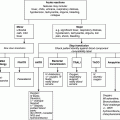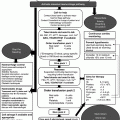Chapter 7 Sarah A. Bennett and Roopen Arya King’s Thrombosis Centre, Department of Haematological Medicine, King’s College Hospital NHS Foundation Trust, London, UK Risk factors for venous thromboembolism (VTE) in intensive care unit (ICU) patients are more heterogeneous than in other care groups but frequent due to the nature of critical illness. Different clinical presentations of VTE like haemodynamic instability, episodes of desaturation and limb swelling are common signs in these patients, which may also be attributed to thrombosis. Concurrently, bleeding risk can be high for a number of reasons, including trauma, recent surgery, organ dysfunction and the associated coagulopathy. The importance of preventing VTE in this patient group however should not be underestimated. Omission of early thromboprophylaxis (within 24 h of admission to ICU) is associated with more severe episodes of VTE and increased mortality [1]. Venous thromboembolism in the ICU patient group is often asymptomatic, and rates are therefore difficult to estimate. Cross-sectional studies have demonstrated that up to 10% of patients have pre-existing deep vein thrombosis (DVT) on admission to ICU. Clinicians should therefore be vigilant and consider the diagnosis in all patients admitted to their unit and prescribe thromboprophylaxis in the absence of any absolute contraindications. In this respect, studies have shown that up to one-third of patients who do not receive thromboprophylaxis in ICU will develop a DVT [2]. The estimation of PE incidence has been more difficult to ascertain since even when PE leads to death, diagnosis is not often confirmed due to reduced post-mortem rates – patients who were ventilated or treated for other pulmonary conditions as well as trauma victims are less likely to have post-mortems. Six studies in critically ill patients over the past three decades revealed PE on post-mortem examination in up to 27% of patients, the majority of which were unsuspected. PE either caused or contributed to death in 10% of these patients. The increased susceptibility to the development of VTE results from numerous factors and can be helpfully thought of as those that are present before ICU admission and those that are acquired during the ICU admission (see Table 7.1). While the relative contribution of each is unknown, patients with multiple risk factors should be deemed at the highest risk and receive thromboprophylaxis as appropriate. Efforts should be made to minimize cumulative risk where possible, such as the use of minimal sedation and shorter periods of central venous catheters. Table 7.1 Risk factors for VTE in intensive care patients. Source: Adapted from Geerts et al. [3]. Copyright Elsevier. Reproduced with permission. All patients in critical care are at high risk of VTE, and thromboprophylaxis should be given routinely. There is evidence to suggest that by doing so the incidence of proximal DVT can be reduced by around 50% [4–6]. Prophylactic dose heparin (unfractionated heparin (UFH) and low-molecular-weight heparin (LMWH)) has been compared to placebo in a handful of studies examining the efficacy of DVT prevention in general ICU patients. Pharmacological thromboprophylaxis reduced the rate of VTE by at least 55%. Whether one type of heparin is superior in preventing VTE than the other remains unknown in this group of patients. The PROTECT study provides the only direct comparison between UFH and LMWH in preventing VTE in critical care patients [7]. This multicentre study involving 3764 randomized ICU patients (with the exception of trauma, orthopaedic and neurosurgical patients) showed no significant difference in the rate of proximal DVT (5.8% UFH and 5.1% dalteparin) between the two groups. Fewer patients receiving dalteparin developed PE (1.3% vs. 2.3%) although the hospital mortality rate did not differ between the groups. Major bleeding rates were comparable, and there were fewer cases of heparin-induced thrombocytopenia (HIT) in the dalteparin cohort. Low-molecular-weight heparin is increasingly favoured over UFH due to the reduced incidence of HIT and osteoporosis and the high bioavailability and largely predictable anticoagulant effects. LMWHs do not require routine monitoring or dose adjustments, but serum anti-factor Xa levels may offer guidance and have been successfully used in certain patient groups where the pharmacokinetics are more unpredictable. Although trials often focus on laboratory parameters such as anti-Xa levels as surrogate markers for anticoagulant effectiveness, the interpretation of these tests in ICU patients has not been extensively studied. It is also useful to bear in mind that increased body weight, multi-organ dysfunction and high vasopressor requirements with the resulting impairment to cutaneous blood flow may all lead to underdosing of heparins. Besides, medications administered subcutaneously in patients with shock may not be reliably absorbed. In those patients with antithrombin deficiency (e.g. severe sepsis), heparin administration without monitoring can lead to underdosing as well. Conversely, bioaccumulation (particularly with repeated administration) may occur in patients with renal insufficiency, leading to overdosing and haemorrhagic complications. There is very little evidence to guide clinicians on the use of mechanical measures to prevent VTE in medical as well as in ICU patients. Anti-embolism stockings (AES), intermittent pneumatic compression (IPC) and foot impulse devices are the main modalities (see Table 7.2). Mechanical devices should be considered in conjunction with pharmacological prophylaxis in high-risk patients when the clinical condition allows. Immobility is a universal risk factor for critically ill patients, and the main aim with these methods is to reduce the resultant venous stasis. At times, the bleeding risk for the patient may be increased such that the risk/benefit ratio dictates that pharmacological thromboprophylaxis is relatively or absolutely contraindicated.
Venous Thromboembolism in Intensive Care
Introduction
Epidemiology
Risk factors for development of VTE in intensive care
Present prior to intensive care unit (ICU) admission:
Age (>60 years)
Personal (or first-degree relative with) history of venous thromboembolism (VTE)
Known thrombophilias
Intimal injury (e.g. trauma, surgery)
Hypercoagulability (active cancer or cancer treatment, sepsis, dehydration)
Obesity (BMI > 30 kg/m2)
Reduced mobility (e.g. spinal cord injury, bed rest for ≥ 3 days, stroke)
Hormonal factors (pregnancy or up to 6 weeks postpartum)
Significant co-morbidities (e.g. heart disease, endocrine and respiratory pathology, acute infectious diseases and inflammatory conditions)
Acquired during ICU admission:
Use of sedation and muscle relaxant infusion
Invasive/non-invasive positive pressure ventilation
Intravascular catheter device
Sepsis
Renal replacement therapy
Vasopressor requirement
Haemostasis support (e.g. platelet transfusion and recombinant factor VIIa)
Thromboprophylaxis
Pharmacological
Mechanical
Stay updated, free articles. Join our Telegram channel

Full access? Get Clinical Tree






